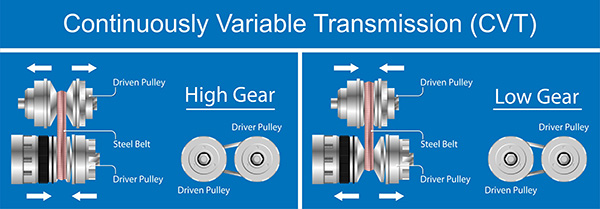
When it comes to car transmissions, most people are familiar with the traditional automatic or manual options. But there's another type of transmission that’s becoming increasingly popular: the Continuously Variable Transmission, or CVT. If you've ever driven a car with a CVT, you might have noticed that it feels a bit different from what you're used to. But how exactly does a CVT transmission work, and what sets it apart from the other types?
What Is a CVT Transmission?
A Continuously Variable Transmission is a type of automatic transmission that doesn’t rely on a fixed set of gears. Unlike a conventional transmission that shifts between a specific number of gear ratios, a CVT seamlessly transitions through an infinite range of ratios. This unique ability allows the engine to operate at its most efficient RPM for a given speed, which can lead to better fuel efficiency and a smoother driving experience.
The CVT's design is deceptively simple. It mainly consists of a belt or chain and two variable-diameter pulleys—one connected to the engine (the input pulley) and the other to the wheels (the output pulley). The pulleys change their width as needed, allowing the belt to move up or down, which in turn alters the gear ratio. This is why a CVT can provide an infinite number of effective gear ratios, as opposed to the fixed gears in traditional transmissions.
How Does a CVT Transmission Operate?
So, how does a CVT transmission work in practice? It’s all about those pulleys and the belt.
Variable Pulleys
The CVT’s pulleys are designed to change their effective diameter by moving closer together or farther apart. When the input pulley narrows, the belt rides higher, increasing the gear ratio and allowing for more power to be delivered to the wheels. Conversely, when the input pulley widens, the belt drops, lowering the gear ratio for smoother cruising or more efficient operation.
Continuous Adjustments
The real magic of a CVT is its ability to continuously adjust the pulley ratios, keeping the engine in its optimal power range. This means that instead of feeling the shift points of a traditional transmission, you experience a seamless, steady acceleration.
Efficiency and Power
The CVT is constantly adapting to driving conditions, whether you’re accelerating from a stop or cruising on the highway. It finds the perfect balance between power and fuel efficiency, which is why CVTs are popular in vehicles designed for fuel economy, like hybrids.
Why Choose a CVT?
Now that we know how a CVT transmission works, you might be wondering why automakers are increasingly opting for this technology in their vehicles. There are several key benefits that make CVTs an attractive choice.
Fuel Efficiency
Because a CVT allows the engine to run at its most efficient RPM, it can significantly improve fuel economy. This is particularly important as automakers strive to meet stricter fuel efficiency standards.
Smoother Driving Experience
With no abrupt gear shifts, a CVT provides a smoother driving experience. This can make your ride more comfortable, especially in stop-and-go traffic or when accelerating.
Compact Design
CVTs are typically lighter and more compact than traditional transmissions. This not only reduces the overall weight of the vehicle, which further improves fuel efficiency, but it also frees up space in the engine bay.
Drawbacks of CVTs
Of course, no technology is without its downsides, and CVTs are no exception. While they offer numerous benefits, there are a few potential drawbacks to keep in mind.
Driving Feel
Some drivers find the driving experience of a CVT to be less engaging. Without the distinct shift points of a traditional transmission, the sensation can feel unnatural, especially for those accustomed to the feedback of gear changes.
Durability
Although CVTs are generally reliable, they can be more sensitive to wear and tear compared to traditional transmissions. The belt or chain can wear out over time, leading to potentially expensive repairs. Regular maintenance is crucial to keep a CVT in good working condition.
Limited Power Handling
CVTs are often found in smaller, more fuel-efficient vehicles, as they can struggle to handle the high torque and power demands of larger, performance-oriented cars.
Is a CVT Right for You?
So, should you consider a car with a CVT transmission? It really depends on your driving preferences and needs. If you prioritize fuel efficiency and a smooth, comfortable ride, a CVT might be a great fit for you. However, if you enjoy a more engaging driving experience with the feel of gear changes, you might prefer a traditional automatic or manual transmission.
Is your transmission not performing as it should? Bud's Auto Repair & Transmission is here to help. Our skilled technicians can diagnose and repair your transmission issues. Contact us today to ensure a smoother ride!